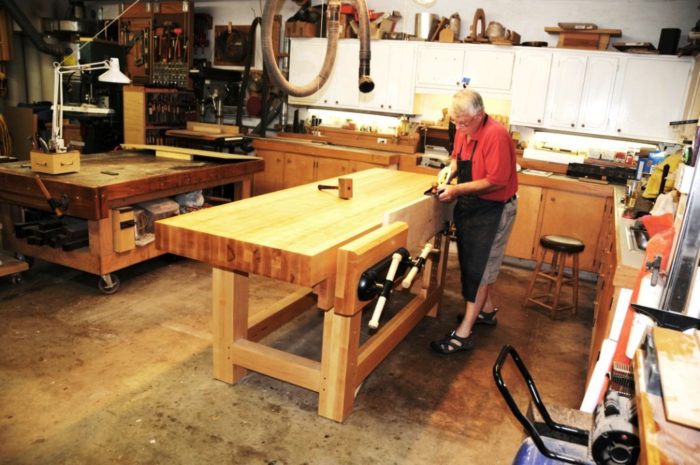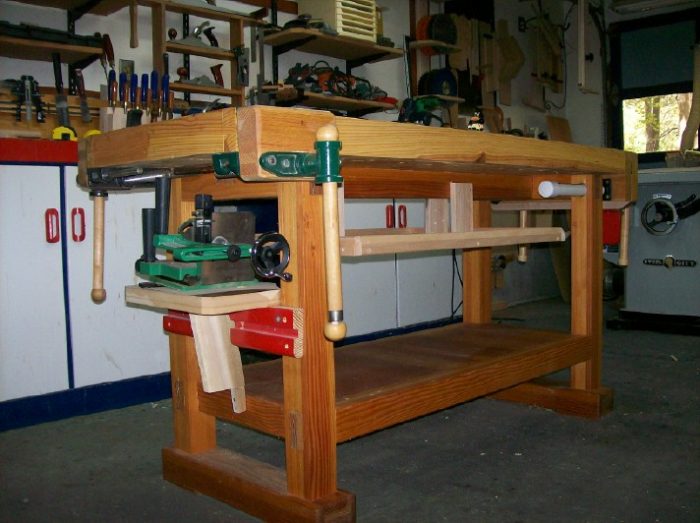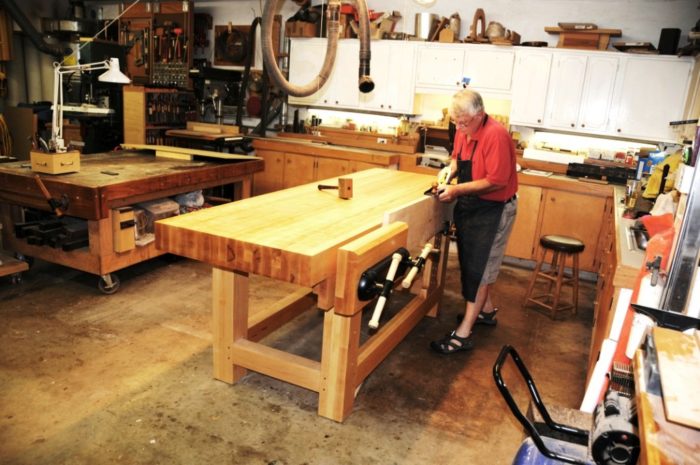Do you enjoy working with wood and creating beautiful pieces of furniture or crafts? Then you’ve probably wondered, “How thick should a woodworking bench top be?” Well, my young woodworking enthusiast, you’ve come to the right place! In this article, we’ll dive into the perfect thickness for a woodworking bench top and why it matters.
When it comes to woodworking, the thickness of your bench top is crucial for stability and durability. A sturdy and reliable bench top is the foundation for all your woodworking projects. So, let’s explore the factors that determine the ideal thickness that will ensure your bench top can withstand the test of time.
Whether you’re a novice or an experienced woodworker, understanding the optimal thickness of a woodworking bench top is vital for your craft. So, let’s roll up our sleeves and get ready to discover the secrets of a perfect bench top thickness!
When it comes to woodworking bench tops, the thickness is an important factor to consider. While there is no one-size-fits-all answer, it largely depends on the type of woodworking projects you’ll be working on. For general-purpose woodworking benches, a thickness of 1.5 to 2 inches is recommended. However, if you’ll be handling heavier work or using power tools, opting for a thicker bench top of 3 inches or more would provide better stability and durability.

How Thick Should a Woodworking Bench Top Be?
A woodworking bench top plays a crucial role in any woodworking project, providing a stable and sturdy surface to work on. But what is the ideal thickness for a woodworking bench top? In this article, we will explore the factors to consider and provide recommendations to help you determine the perfect thickness for your bench top. Whether you are a seasoned woodworker or just starting out, understanding the right thickness for your bench top is essential for achieving the best results in your woodworking endeavors.
Factors to Consider When Determining Bench Top Thickness
There are several factors to take into account when determining the thickness of your woodworking bench top. Let’s dive into these factors in more detail:
The Type of Wood
The type of wood you choose for your bench top will greatly influence its overall strength and stability. Hardwoods like oak, maple, and beech are commonly used for their durability and ability to withstand heavy use. Softer woods may require a thicker bench top to provide the necessary support. It is important to choose a wood species that can handle the tasks you plan to undertake on your bench top.
Furthermore, different wood species have varying levels of stability, which can affect the required thickness. Wood that is prone to warping or shrinking may necessitate a thicker bench top to mitigate these issues.
Consider the properties of the wood you are using and select a thickness that will provide sufficient support and stability for your woodworking projects.
The Weight of the Workpieces
Another crucial factor to consider when determining bench top thickness is the weight of the workpieces you plan to work on. If you frequently undertake heavy-duty projects or handle large, cumbersome materials, a thicker bench top will be necessary to ensure stability and prevent sagging or flexing. On the other hand, if you primarily work with smaller, lighter materials, a thinner bench top may be sufficient.
By considering the weight of the workpieces, you can select a bench top thickness that will provide optimal support and prevent any potential issues that may arise from excessive weight.
The Type of Joinery Techniques
The joinery techniques you employ in your woodworking projects can also impact the required thickness of your bench top. Certain joinery techniques, such as dovetail joints or mortise and tenon joints, place greater stress on the bench top and may require additional thickness to ensure stability.
Additionally, if you plan to utilize clamps or other securing methods that require a solid and stable surface, a thicker bench top will be necessary to accommodate these techniques.
Consider the joinery techniques you commonly use and select a bench top thickness that can withstand the demands of your woodworking projects.
The Overall Size of the Bench
The overall size of your woodworking bench is another factor to take into account when determining bench top thickness. A larger bench will typically require a thicker top to adequately distribute weight and prevent any sagging or flexing.
If you plan to have a small bench or a dedicated space for specific tasks, a thinner bench top may be sufficient. However, if you have a larger work area or plan to undertake a wide range of projects, a thicker bench top will provide the stability and support needed to handle varying tasks.
Consider the size of your bench and the space you have available when determining the ideal thickness for your bench top.
The Recommended Thickness Guidelines
Based on the factors mentioned above, here are some recommended bench top thickness guidelines:
For General Woodworking Projects
If you engage in general woodworking projects, such as furniture making, cabinetry, or smaller-scale home improvement tasks, a bench top thickness between 3 to 4 inches is typically sufficient. This thickness provides stability and support for most common wood species and joinery techniques.
For Heavy-Duty or Industrial Applications
For heavy-duty woodworking or industrial applications, where you will be handling larger and heavier workpieces, a thicker bench top is recommended. A thickness of 4 to 6 inches or more will ensure the necessary support and prevent any sagging or flexing under the weight.
For Specialty Woodworking Tasks
If you specialize in specific woodworking tasks that require extra stability or have unique demands, it may be necessary to deviate from the general guidelines. Consider the specific requirements of your specialty woodworking tasks and adjust the bench top thickness accordingly. Seek advice from experienced woodworkers or professionals in your area of expertise for tailored recommendations.
Additional Considerations
When determining the thickness of your woodworking bench top, there are a few additional considerations to keep in mind:
Construction Method
The construction method you choose for your bench can affect the required thickness. If you are building a laminated bench top, where multiple layers of thinner wood are glued together, a thinner overall thickness may be acceptable. However, if you are working with solid wood, a thicker bench top will provide greater stability and durability.
Noise and Vibration Dampening
If you work with power tools or perform tasks that generate a lot of noise and vibration, a thicker bench top can help dampen these disturbances, providing a more comfortable and quieter work environment. Thicker tops have better sound-absorbing properties and can help reduce the transfer of vibrations to the work surface.
Budget and Availability
Lastly, your budget and the availability of materials may influence the thickness of your bench top. Thicker bench tops generally require more materials and can be more expensive. Consider your budget and the availability of suitable wood species when making your decision.
By considering these factors and guidelines, you can determine the ideal thickness for your woodworking bench top. Remember that the specific requirements may vary based on your individual needs and the projects you undertake. Experimentation and experience will ultimately help you find the perfect bench top thickness for your woodworking endeavors. Happy woodworking!
Key Takeaways: How Thick Should a Woodworking Bench Top Be?
- A woodworking bench top should ideally be at least 2 inches thick for stability and durability.
- A thicker bench top, around 3 to 4 inches, can provide even more stability and support for heavy workpieces.
- Consider the type of woodworking projects you will be working on when choosing the thickness of your bench top.
- For lighter projects, a 2-inch thick bench top is usually sufficient.
- If you plan on using hand tools or doing heavy-duty work, a thicker bench top will be more suitable.
Frequently Asked Questions
When it comes to woodworking bench tops, thickness is an important consideration. Here are some common questions and answers to help guide you in determining the optimal thickness for your woodworking bench top.
1. Why does the thickness of a woodworking bench top matter?
The thickness of a woodworking bench top plays a crucial role in its stability and durability. A thicker bench top provides a solid and stable work surface that can handle heavy workpieces and withstand the pressure and vibrations that come with woodworking tasks. It also helps absorb impacts and reduces the risk of the bench top warping or flexing over time.
Additionally, a thicker bench top allows for easier installation and attachment of vises, clamps, and other woodworking accessories, as it provides more material to securely anchor them to the bench.
‘2. What is the recommended thickness for a woodworking bench top?
The recommended thickness for a woodworking bench top typically ranges between 2.5 to 4 inches, depending on the specific requirements and preferences of the woodworker. A 2.5-inch thick bench top can provide sufficient stability for most woodworking tasks, while a 3 to 4-inch thick bench top is often preferred for heavy-duty woodworking or when working with particularly large or heavy workpieces.
Ultimately, the desired thickness should be determined by considering the types of projects you plan to work on, the weight and size of the workpieces you expect to handle, and your personal comfort and preference in terms of stability.
3. What are the benefits of a thicker woodworking bench top?
A thicker woodworking bench top offers several benefits. Firstly, it provides enhanced stability and reduces the risk of the bench top flexing or vibrating during woodworking tasks. This is particularly important when working with hand tools or performing tasks that require precision.
In addition, a thicker bench top offers more material for attaching woodworking accessories, such as vises and clamps, making it easier to secure workpieces in place. It also provides increased resistance to warping or twisting, ensuring that the bench top remains flat and level over time. Finally, a thicker bench top adds a sense of solidity and durability, giving you confidence in its ability to withstand heavy use.
4. Are there any drawbacks to a thicker woodworking bench top?
While a thicker bench top has its advantages, there are a few potential drawbacks to consider. One is the increased weight of the bench, which can make it more challenging to move or transport. It may also require a sturdier base or support structure to handle the additional weight.
Another consideration is the cost. Thicker bench tops typically require more material, which can drive up the overall cost of the project. Additionally, if you plan to attach accessories to the bench, such as vises or clamps, you may need longer bolts or hardware to accommodate the increased thickness.
5. Can I build a woodworking bench top that is too thick?
While there is no specific thickness that would be considered “too thick,” it’s important to strike a balance between thickness and practicality. Building an excessively thick bench top may not provide any significant added benefits and can result in unnecessary weight and material costs. It’s essential to consider your specific woodworking needs and choose a thickness that offers the desired stability, functionality, and durability without going overboard.
It’s also worth noting that a thicker bench top may require more substantial legs and supports to maintain proper balance and stability. Ensuring the overall structure of the bench is designed to support the increased thickness is essential for optimal performance.

Summary
So, to sum it up, the thickness of a woodworking bench top depends on a few things. First, consider how you’ll use it. Will you be doing heavy work that requires a sturdy surface? If so, a thicker bench top, around 3 to 4 inches, might be best. But if you’re doing lighter projects, a 2-inch thick bench top should suffice. It’s also important to think about the type of wood you’re using. Hardwoods like maple or oak are more durable and can handle a thinner bench top, while softwoods like pine might need a bit more thickness. And don’t forget to consider your budget and available space before making a decision. Ultimately, choose a thickness that suits your needs and suits the tools and projects you’ll be working on. Happy woodworking!
